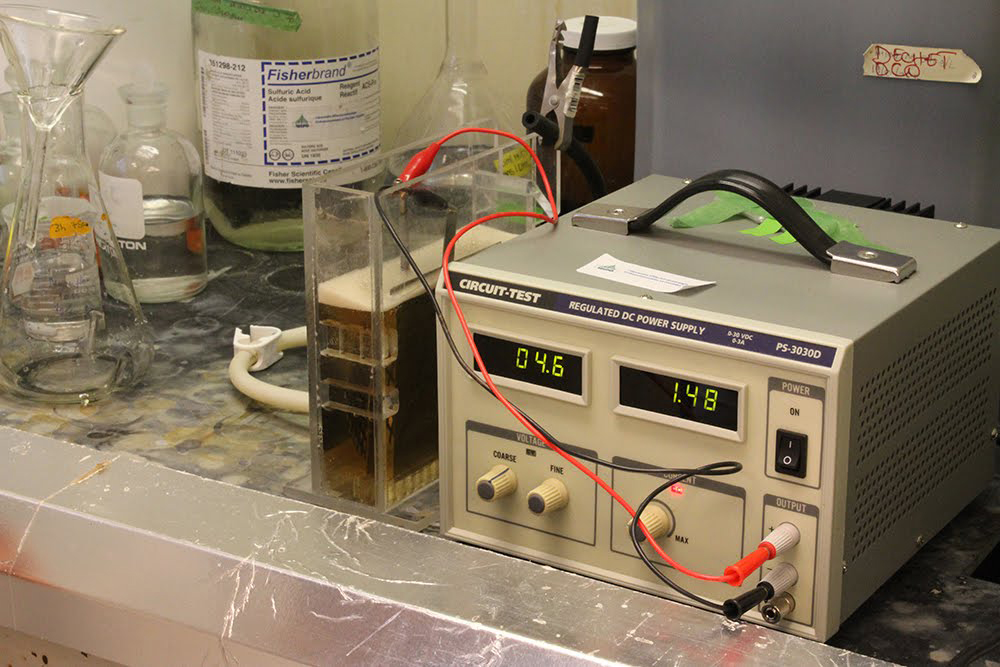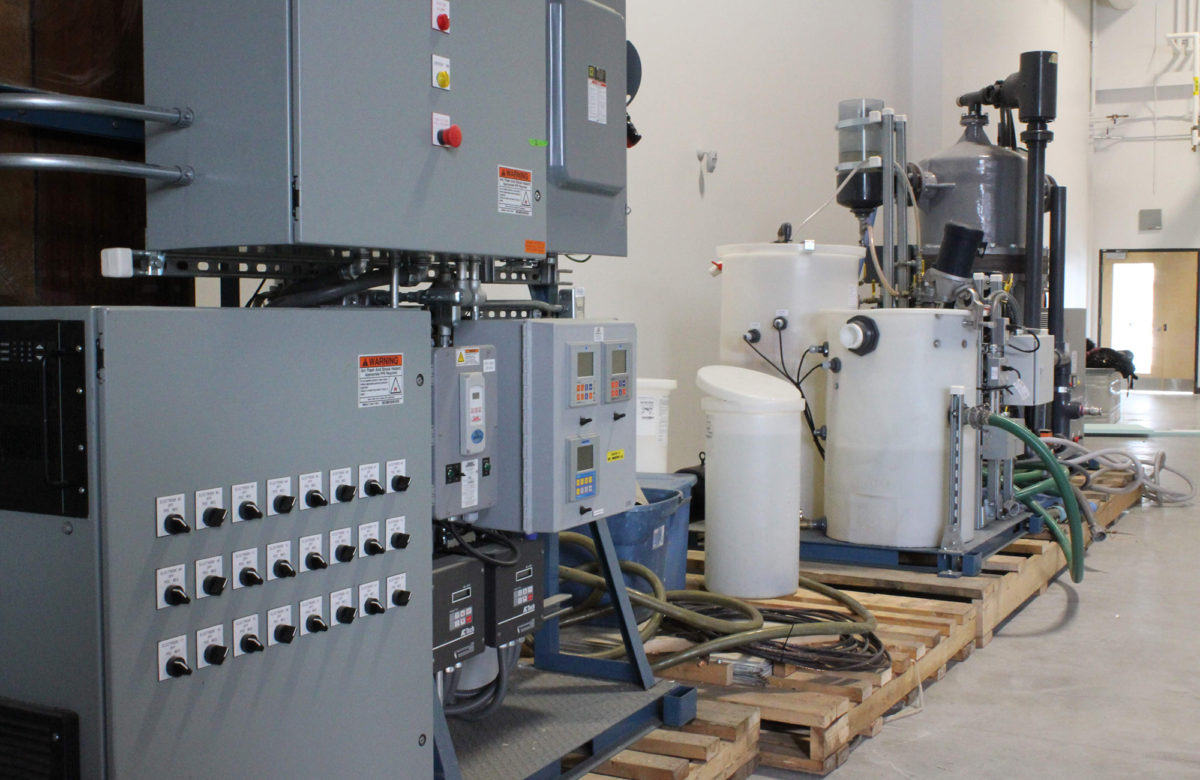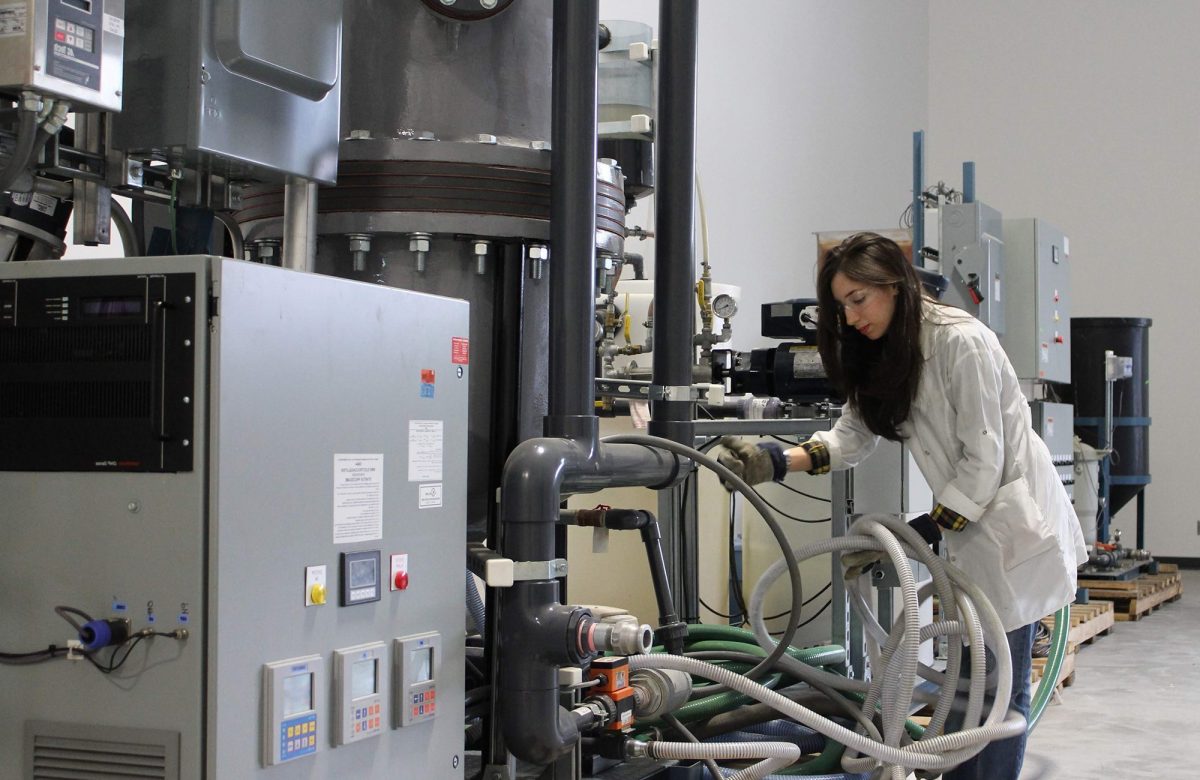How to eliminate emerging refractory contaminants such as drug residues in hospital wastewater. How to disinfect and treat water without chemicals. How to treat wastewater using renewable energy. Laboratory of Environmental Electrotechnologies and Oxidative Processes (LEEPO) finds solutions to all these issues.
LEEPO develops electrolytic techniques and oxidative processes to improve water treatment systems (from drinking water to municipal and industrial wastewater treatment) and replace inefficient conventional technologies for removing refractory organic, inorganic, and microbial contaminants.
The electrolytic and oxidative processes LEEPO develops can be easily integrated into current water treatment systems. The laboratory features the following facilities and equipment:
Laboratory scale treatment and control units
- Electro-oxidation/electrodeposition (EC-ED) treatment units, 2 m high and 1 m wide each (2)
- Electrocoagulation/electroflotation (EC-EF) treatment units, 2 m high and 1 m wide each (2)
- Tangential ultrafiltration/microfiltration treatment unit, 2 m high and 1 m wide
- Membrane bioreactor (MBR) treatment unit, 2 m high and 1 m wide (three laboratory membrane bioreactors, including electro-MBR)
- Photo-catalytic unit
- Two electro-photocatalytic units
- Ozonation treatment unit
- Sonication treatment unit
- UV cell
- Jar-test shaker unit
- Thermoregulator
- HDPE reactor (10, 15, and 30 gallons)
- Two solar simulators
- Small equipment: shakers, pH-meters, etc.
Analytical instruments
- Cary 50 UC/visible light spectrophotometer with microplate reader coupled to a computer
- Potentiostatic/galvanostatic Voltlab 80 analytical radiometer coupled to a computer
- Potentiometric titrator coupled to a computer
- Turbidity metre
- Hot plates and shakers
- Rotary evaporator
- Lubricated pumps for vacuum filtration (2)
- Oxygen analyzer
Assembly, reagent storage, oven and scale room
- Hach COD/TOC reactor
- Oven
- Analytical scales
- Chemicals
- Storage space for various types of electrodes
- Crucibles, pans, mortars, etc.
Pilot scale units at the large-scale laboratories (LISTE, Technological Park)
- EC-EF pilot-scale unit (200 to 300 L)
- EO-ED pilot-scale unit (200 to 300 L)
- Electromembrane (EM) pilot-scale unit (200 to 300 L)
LEEPO offers a range of services to municipalities and industry to help them improve their wastewater treatment systems. The LEEPO research team also has the required expertise to provide innovative solutions for removing refractory organic, inorganic, and microbial contaminants. LEEPO conducts research in the following areas:
Analytical electrochemistry (voltammetry)
Identification of the most appropriate electrodes for breaking down refractory pollutants (e.g., phenolic compounds, PAHs, organochlorine compounds, dioxins, pesticides, drug metabolites, etc.) and design of electrolytic units.
Development of electro-oxidation/electrodeposition (EO-ED) treatment processes
Use of the direct/indirect effects of electric current during electrolysis to eliminate various types of pollutants (endocrine disruptors, toxic metals, and pathogenic germs), with a potential application for oxidative pretreatment and tertiary wastewater treatment.
Development of electrocoagulation/electroflotation (EC-EF) treatment processes
Electrolytic water clarification and disinfection and phosphate removal treatment (removal of colloids, metals, oils and fats, TSS, turbidity, bacteria, etc.). Polishing treatment.
Development of electromembrane treatment processes (EM)
Development of coupled technologies: combination of electrochemical and membrane techniques for optimal removal of refractory organic and inorganic micropollutants (electrolysis oxidizes small impurities more easily, while ultrafiltration is more effective for removing large particles).
Development of electro MBR processes, combining electrocoagulation (EC) and a membrane bioreactor (MBR) for treating refractory wastewater (e.g., landfill leachate, compost leachate, hospital wastewater, etc.).
Development of electro-photocatalytic treatment processes (EPC)
Development of coupled technologies: combination of electrochemical and photocatalytic techniques for eliminating organic micropollutants (pesticides, drug residues, cosmetics, etc.).
LEEPO has carried out a number of government- and industry-funded research projects. Here are a few examples:
- Green/advanced decontamination and decentralized wastewater treatment technologies (NSERC Discovery Grant)
- Development of a hybrid process for decontaminating and reusing wastewater from commercial laundries (NSERC Collaborative Research and Development Grant)
- Development of electrolytic processes for recovering and reusing chloride salts from road de-icing water for disinfecting drinking water (NSERC Collaborative Research and Development Grant)
- Development of an innovative membrane bio-treatment technology for leachates from static composting piles (NSERC Collaborative Research and Development Grant)
- Prototype design and technology transfer of a portable electrolytic water treatment unit for use in rural areas (grant from Ministère des Relations internationales et de la Francophonie, Quebec-Haïti cooperation program).
- Development of an innovative catalytic absorption process using xerogels to eliminate emerging pollutants (grant from Ministère des Relations internationales et de la Francophonie, Quebec-Wallonia-Brussels cooperation program)
- Development of a hybrid system for the treatment of agri-food effluents contaminated by antibiotics and hormones (grant from Ministère des Relations internationales et de la Francophonie, Quebec-Mexico Working Group)
- Source removal of drug residues from hospital wastewater: an innovative approach to treating emerging contaminants (NSERC Strategic Project Grant)
- Feasibility of producing bioplastics from cashew apple juice in Ivory Coast (grant from INP-HB, Ivory Coast)
- Development of ultra-oxidizing electrolytic technology for tertiary treatment of slaughterhouse wastewater (contract with PLT Environnement Inc.)
- Treatment of landfill leachate by combining biofiltration through an organic medium (BIOSOR) and electrocoagulation (FRQNT Innovation Networks Support Program grant)
- Development of electrotechnologies to treat water contaminated by endocrine disruptors and other inorganic and microbial pollutants (NSERC Discovery Grant)
- Study on the performance of an activated carbon treatment unit for the removal of cyanobacteria and cyanotoxins from drinking water (Service contract with Roches Ltd., Consulting Group)
Visit the Laboratory Website for more information on our research projects.
Most of LEEPO’s facilities and equipment were purchased with funding from the Canada Foundation for Innovation (CFI) and the Natural Sciences and Engineering Research Council of Canada (NSERC).
Contacts
Boutaina El Jai
Partnerships and Research Development Advisor
Phone: 418 654-2531
boutaina.el_jai@inrs.ca
Laboratory of Environmental Electrotechnologies and Oxidative Processes
Institut national de la recherche scientifique
Eau Terre Environnement Research Centre
490 rue de la Couronne
Quebec City, Quebec G1K 9A9
Canada




